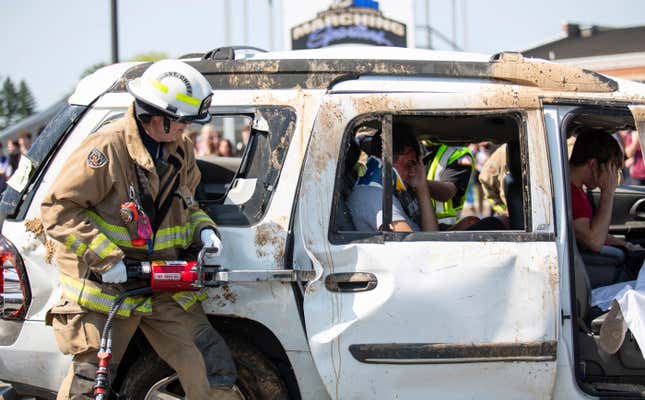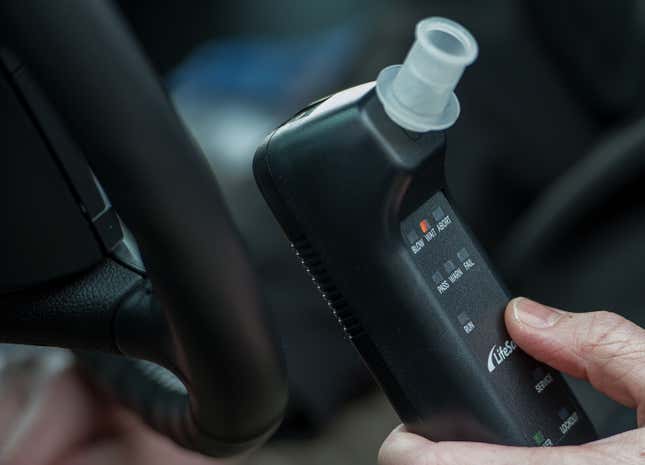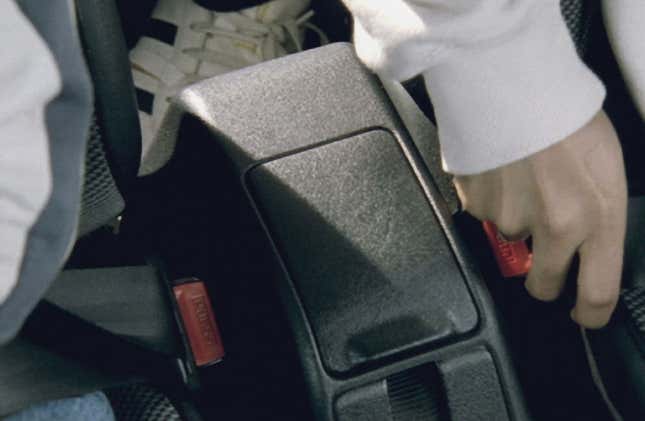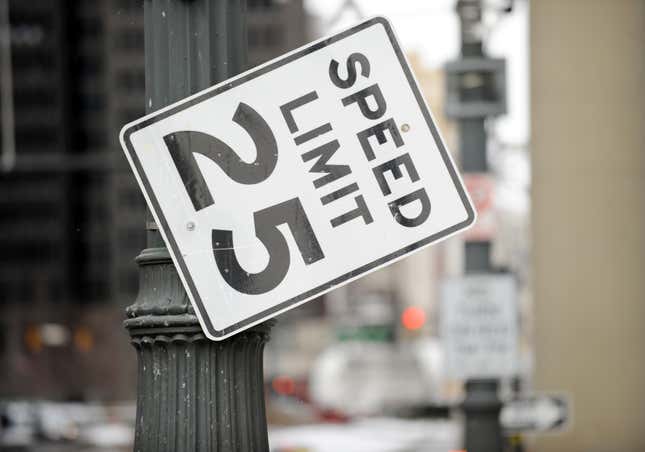
This week, the National Highway Traffic Safety Administration released preliminary data on the traffic fatalities recorded across the country in 2021. Old or young, driver or pedestrian, rural or urban, more Americans died in crashes in 2021 than at any time in the past 15 years.
Fatalities rose to nearly 43,000 in 2021, a 10.5-percent increase over 2020 — and the quickest single-year jump in fatalities NHTSA has ever recorded since its founding 47 years ago. The year before wasn’t much better: While many of us stayed off the roads during COVID lockdowns, 2020 saw 38,824 fatalities — a 6.7-percent increase in deaths despite a 22-percent decrease in reported crashes.
Any time we talk about traffic fatalities, all sorts of possible solutions get thrown out there. U.S. Transportation Secretary Pete Buttigieg cited measures in the recently passed infrastructure law as well as policies in the newly launched National Roadway Safety Strategy as steps the government was taking to curb deaths.
But the National Roadway Safety Strategy merely exists as a .pdf document full of statistics and vague ideas about safety requirements. The infrastructure bill’s best efforts at improving road safety come down to incentives to redesign dangerous roads, and changes in safety requirements for automakers. Neither one of those can be implemented with any speed.
There has to be a quicker way to cut down on all these deaths. And indeed there is. NHTSA cites this statistic in its 2020 traffic fatality report:
In 45% of fatal crashes, the drivers of passenger vehicles were engaged in at least one of the following risky behaviors: speeding, alcohol impairment, or not wearing a seat belt.
The uncomfortable truth is, we could all but eliminate deaths via drunk driving, speeding and lax seat belt use — nearly half of all car crash fatalities — with technology that has been readily available for decades. But we don’t, because they present, at worst, a mild inconvenience.
Breathalyzer Ignition Interlock

Despite decades of education and enforcement programs, local law enforcement handed out over a million DUIs last year, according the Insurance Institute for Highway Safety. Drunk driving has been a factor in 30 percent of fatal crashes every year for the past decade. In 2021, alcohol-related fatalities rose 5 percent over the year before.
If you’ve never been charged with a DUI, you might be unfamiliar with a breathalyzer ignition interlock device. In use since the mid-’80s, it’s a contraption about the size of a smartphone attached to the car’s dashboard or steering column. To start the car, the driver has to blow into a tube; the machine must determine the driver’s blood-alcohol content is below the legal limit (or a lower limit set by a judge) before it allows the car to start. Nearly 350,000 people in the United States have breathalyzer interlocks on their cars, according to the New York Times, twice as many as just a decade ago.
A recent study from the IIHS found that breathalyzer ignition interlock devices could reduce American road fatalities by at least 10,000 deaths every year. But they would have to be installed on every vehicle on our nation’s roads. You may have heard the recently passed Infrastructure Investment and Jobs Act will require automakers to install a passive version of this device in all new cars. It’s a little less cut-and-dry than that.
The act merely instructs the National Highway Safety Administration to finalize rules for ignition interlock technology within the next three years. There’s already a plan built into the requirements to handle a delay, which most observers think is inevitable. Consider that NHTSA has known since 2008 that it should be crash-testing cars for pedestrian safety, as is done under the European NCAP program. But pedestrian crash testing still hasn’t begun, 14 years later. The NHTSA is not the fastest governmental agency around.
Once breathalyzer interlock rules are eventually finalized, automakers will have another two years (or more — manufacturers can find lots of ways to delay) to begin integrating the technology into their new vehicles. There won’t be any ungainly black boxes hanging from your steering column — your car will test your breath without you even realizing it.
Also consider the age of the vehicles on U.S. roads. Last year, the average car in America was 12.1 years old, according to CNBC. Cars are lasting longer than ever, and the Infrastructure Act only requires future breathalyzer rules to apply to new cars. It is, of course, technically feasible to install a breathalyzer interlock on an older car — the process usually costs a DUI offender around $100 and takes no more than 2 hours. But there is zero political or economic will to make breathalyzer interlocks mandatory in the millions of vehicles currently roving America’s roads. So even if the new rule ends up requiring breathalyzers in every newly-built vehicle, it could take decades to truly make a difference in road deaths.
Seatbelt Ignition Locks

This stat is straight from the NHTSA and is so jaw-dropping it speaks for itself:
Of the 22,215 passenger vehicle occupants killed in 2019, 47% were not wearing seat belts.
Seat belts saved an estimated 14,955 lives and could have saved an additional 2,549 people if they had been wearing seat belts, in 2017 alone.
It’s such an easy thing to do, with such an incredible safety benefit, and still, folks make the decision not to buckle up. NHTSA says over 90 percent of Americans use a seatbelt when they’re in a car. The remaining 10 percent make up nearly half of those who die in crashes.
Unlike breathalyzer locks, a plan to increase seatbelt usage is nowhere in President Biden’s infrastructure plan. That’s startling, in part because technology exists that can prevent a car from starting until every occupant’s belt is buckled. We’ve had it since 1970—only two years after NHTSA made three-point seatbelts mandatory in every new car sold in America. But in 1973, when NHTSA tried to mandate seatbelt interlocks in new cars, the public uproar was outrageous. Congress responded by watering down the requirement, changing it from an ignition-switch interlock to an eight-second warning chime on vehicle start-up.
Today, NHTSA regulations only require a continuous or intermittent audible signal that lasts for 4 to 8 seconds on startup, or alerts for at least 60 seconds if a front seat occupant is unbuckled. Seat belts are so ignored as a safety device, only 34 states allow police to pull over drivers for not buckling up. Ten states have no laws at all when it comes to buckling back-seat passengers (where you’re most likely to find small children), according to the Governors’ Highway Safety Association.
There is one bright spot: General Motors goes above and beyond by including Buckle To Drive on all of its new vehicles starting this year. It works the same as the seatbelt-interlock proposed by NHTSA back in 1973: If the driver is unbuckled, the car won’t shift out of Park. It’s a simple and cheap technology, and while GM’s system only applies to the driver, it shows that other automakers could easily choose to implement such technology to help keep their customers alive.
Speeding

Listen. Driving fast is a singularly wonderful experience. But it’s also, by far, the single deadliest factor in fatal automotive crashes. In 2019, the most recent year data is available, NHTSA says 9,478 Americans died in crashes where law enforcement noted speed as a factor.
Of course, all car crashes involve speed to a certain extent. NHTSA counts speed as a factor in a fatal crash if it’s noted as a contributor by law enforcement on the scene, or if a driver involved in the crash is charged with excessive speed. NHTSA doesn’t specify a threshold beyond which a car is “speeding.”
But we know that even modest speeds can be deadly. AAA Foundation for Traffic Safety, the Insurance Institute for Highway Safety and a crash testing company called Humanetics showed exactly how speed contributes to injury or death in a test conducted last year:
The AAA Foundation collaborated with IIHS and Humanetics, the leading manufacturer of biofidelic crash test dummies, to examine how speed affects the likelihood and severity of occupant injury in a crash. Three 2010 Honda CR-V EX crossovers were used because they represented the average age (11.8 years) of a typical vehicle on U.S. roadways and earned the top rating in the IIHS moderate overlap front test. Calspan Corporation conducted all the tests in its crash laboratory in Buffalo, New York.
As the crash speed increased in the tests, researchers found more structural damage and greater forces on the dummy’s entire body.
Higher speed limits cancel out the benefits of vehicle safety improvements like airbags and improved structural designs, said Dr. David Harkey, IIHS president. The faster a driver is going before a crash, the less likely it is that they’ll be able to get down to a survivable speed even if they have a chance to brake before impact.
At the 40 mph impact speed, there was minimal intrusion into the driver’s space. But at the 50 mph impact speed, there was noticeable deformation of the driver side door opening, dashboard and foot area. At 56 mph, the vehicle interior was significantly compromised, with the dummy’s sensors registering severe neck injuries and a likelihood of fractures to the long bones in the lower leg.
NHTSA has all but given up on making American drivers slow down. Its approach is marketing, outfitting cops with better radar equipment and redesigning roads to force drivers to slow down. The technology exists to force drivers to obey the speed limit. It’s existed for as long as cars have been around: a speed-limiting governor. And admittedly, drivers hate the very idea.
Now we have a modern, more technologically advanced version of that technology. It’s called Intelligent Speed Assistance. In 2019, the European Parliament made ISAs a requirement for new cars starting this year. The device isn’t like a traditional governor, which mechanically limits a vehicle to a certain top speed. Here’s how it works, from Autocar:
According to the European Transport Safety Council (ETSC), which advised the European Parliament on ISA systems, speeding is a major problem in many European countries, with a large proportion of the 500 deaths each week on EU roads caused by drivers going too fast. Research in Sweden and the Netherlands has shown that when using an ISA system, motorists drive more slowly, even when it can be switched off.
“The EU has a once-in-a-generation opportunity to make a massive difference,” says Graziella Jost, projects director of the ETSC. “Fitting intelligent speed assistance on every new vehicle as standard could eventually prevent a fifth of road deaths.”
The system that will become mandatory on new cars in 2022 uses a forward-facing camera mounted on the car and the vehicle’s satellite navigation system to identify the speed limit and, if the car is exceeding it, to restrict the fuel flowing to the engine until the vehicle is at the limit speed.
At no point does it operate the brakes, so the reduction in the car’s speed is gentle and progressive. As the ISA comes into play, the accelerator pedal becomes unresponsive. The ISA system approved by the EU will be overridable, which means the driver can ignore it by firmly pressing the accelerator. If the driver continues to drive above the speed limit, the system will sound and display a warning for several seconds.
The system is likely to be ‘default on’ – meaning it’s active every time the car is started – but can cancelled by the driver at any time. The ETSC recommended this feature be included during the first few years to make ISA systems more acceptable to motorists. Of course, this means the system could one day be permanently active.
Some automakers, including Ford, Jeep and Honda, already install ISAs in their European-market vehicles. Once the technology becomes commonplace, Europe could reduce its 22,800 annual traffic fatalities by 30 percent.
Why We Won’t See These Solutions Any Time Soon

The problem with all of these solutions is that cars aren’t just transportation in America — they’re a symbol of personal freedom. Stifling that freedom has always been deemed unacceptable by the public, let alone an auto industry that has always resisted safety changes on the basis of cost.
But cars, and car crashes, are an unavoidable part of life for the vast majority of Americans. Many places in the U.S. have little to no public transit. According to a U.S. Census Bureau American Community Survey, 91.55 percent of Americans have access to at least one car for their household. Personal vehicles are not just a hobby for most Americans — they’re basically the only way to get around. We force those people to share the road with speed demons, drunks, and distracted drivers, and lives are lost in the carnage.
It’s a deadly dichotomy that seems unlikely to change. I’m not sure I’d ever want to live with the systems described here, and I’m the kind of driver who won’t shift into gear until every passenger is buckled. But that means acknowledging that potentially, my own life and the lives of other drivers less important to me than my vague idea of freedom or convenience. Until we have a better answer for that, we won’t solve the easiest problems to reduce traffic deaths.